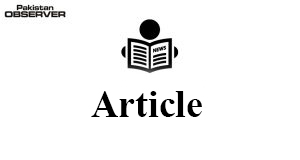Khalil Dogar
ACCORDING to World Health Organisation (WHO), there are over 23.9 million tobacco users in Pakistan, out of which approximately 166,000 are dying every year because of tobacco related diseases. According to a study conducted by Pakistan Institute of Development Economics on average, in Pakistan, smokers spend 10% of their average monthly income on cigarettes, while lower income groups tend to spend more on tobacco products. 25.3% of households in the lowest income group smoke cigarettes compared to 16.2% of households in the highest income group. Since the lower income group already have limited access to healthcare, they tend to face the brunt of the tobacco epidemic in Pakistan. Studies evidently show how at a micro level lower income groups remain trapped in health and economic cost of tobacco consumption and the magnitude of this epidemic becomes clearer when we take into account the total health burden of tobacco on the country. Figures from a study conducted by Pakistan Health Research Council show that tobacco consumption costs the Pakistan PKR 192 billion health burden due to tobacco-related diseases and lost productivity whereas in comparison, the revenue generated from tobacco taxation is only PKR. 115 billion. Pakistan became a Party to the WHO Framework Convention on Tobacco Control (FCTC) on February 27, 2005. However, many of Pakistan’s measures to control tobacco consumption are not completely aligned with FCTC.
Raising tobacco taxes is a proven policy to help reduce tobacco consumption as per the WHO’s recommendations. However, Pakistan has failed to implement this strategy. World Bank Report says that Pakistan should annually increase the excise rates by at least 30% on cigarettes to ensure the reduction in cigarette consumption and the growth of tobacco revenue. According to a study conducted by Social Policy and Development Centre (SPDC) the tobacco industry caused a whopping Rs153 billion loss to the national exchequer from 2016 to 2019 by being awarded low tax rate and adjusting the prices of their most sold brands. This includes low tax rates (Rs. 77.85 billion deficit) and price adjustment of popular brands (Rs. 75 billion deficit). Under-reporting of production by tobacco industry also resulted in lower tax collections by the government. In these years, big tobacco industry produced 75% of the cigarettes in market but claimed to have produced far less amount to avoid taxes. The mixed stance on third tier system has also shown lack of clarity on part of policy makers and implementation authorities. Tobacco industry claimed during 2017 budget that the market share of illicit brands in Pakistan has risen exponentially due to high tobacco taxes on legitimate and tax paying industry and now stands at 40 percent of the total cigarette market. The government institutes had no independent data of their own on the market share of illicit trade and had to rely on the industry’s claims and hence implemented the third tier. As a result of third tier total revenue collected was significantly less than the preceding years and in 2019 FBR had to remove the third tier slab. This has been observed as a common industry tactic in many countries to avoid an increase in taxes and in our case any surcharge on cigarettes.
A study was conducted under the guidance of FCTC Knowledge Hub, Economics of Tobacco Control Project in 2018 that revealed information contradictory to what industry had claimed such as most illicit cigarettes available in the market were of high-end brands rather than the cheaper or lower tier cigarettes, while the total market share of illicit trade was found to be only 10%. Increase in tax has not shown any correlation in increasing the illicit trade in other countries of the world. This interference becomes more evident as one examines the case of Health Levy bill of 2019. In its first budget, PTI government proposed a ‘Sin Tax’ of Rs.10 per pack of 20 cigarette sticks. However according to Ministry of NHS, FBR opposed this move as it is of view that decline in the earnings of big tobacco companies will result in decline on the revenue of FBR. In 2019 cabinet approved ‘The Federal Health Levy Bill, 2019’ presented by Ministry of NHS. However, much to the disappointment of public health and tobacco control activists FBR deferred the presentation of bill in the parliament despite cabinet’s approval on the grounds that “health is a provincial subject and Federation cannot levy health tax on tobacco consumption.”
It is pertinent to mention that the bill was already vetted by the Ministry of Law. Despite being an FCTC signatory – implementation of which is also upheld in Sustainable Development Goal 3.a – Pakistan has no long term policies towards cessation or controlling of tobacco proliferation in the country.. The policy makers and implementation authorities need to see tobacco as an epidemic that it is and need to trust scientific data on it. Jurisdiction issue is another challenge faced by anti-tobacco activists since 18th Amendment in Constitution of Pakistan. After this amendment, health has become a provincial subject and all provinces are required to enact their own laws. However, no efforts have made in this regard hence despite 18 years of passing of federal ordinance, the implementation remains ineffective. In order to counter these challenges, the government needs to adopt a sustainable National Tobacco Control Policy that aims towards reduction in tobacco consumption, mitigating its health cost, and also creating a deterrence for youth from initiating tobacco use Government must have clear guidelines on increasing taxation and health levy on yearly basis according to recommendations of WHO and its implementations must be ensured independent of an interferences from the industry.
—The writer is contributing columnist, based in Islamabad.










